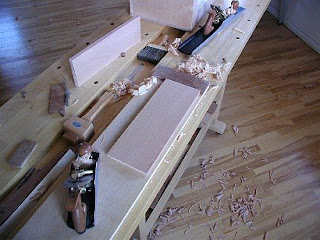 I left off in the previous post with a few boards to flatten and smooth with handplanes. I typically use a planing board with a plane stop at the end to perform this type of work. The boards are relatively small and are easily held against the plane stop. This allows me to quickly flip the board around to plane either side without needing to clamp the board again. If I were planing a larger panel I would most likely fasten it between bench dogs.
I left off in the previous post with a few boards to flatten and smooth with handplanes. I typically use a planing board with a plane stop at the end to perform this type of work. The boards are relatively small and are easily held against the plane stop. This allows me to quickly flip the board around to plane either side without needing to clamp the board again. If I were planing a larger panel I would most likely fasten it between bench dogs. The handplaning of these particular boards is straightforward along their length with little diagonal planing... so it works out well. Handplaning these boards which will comprise the panels for the drawer cases begins with a long fore or jointer plane to flatten the faces of the boards and ensure they are flat and parallel to each other. I also have the final thickness of each board in mind and work towards this. After the individual boards were resawn a little cupping was introduced , inherent to resawing, and although acclimatization to the studio environment helps to relieve this cup and any other tension in the boards, some minimal cupping remains in each of these boards.
I use a jointer plane in this case, I have it tuned and ready most of the time for work like this. A shorter fore plane would also be ideal since the boards are relatively short in length. Once the boards faces are flat with parallel faces I then move on to a finely tuned smoother plane to ensure the faces of the boards are flat as can be. The term which is used for this type of board preparation is four-squaring the board which ensures that both faces and the two long edges are parallel to each other, and the ends and edges are perpendicular. After completing this process on each of the other boards which will comprise the drawer case panels, I will be squaring the ends to achieve both the correct length of each board and to ensure the boards are perfectly square.

3 comments:
Great work.
Thank you.
Hi Norman,
Why do you use the planing board?
Isn't your bench as flat? Just curious....
Hi Luis,
The bench is flat, but I need the plane stop feature of the planing board. I also have a thinner board adapter I often use on the planing board plane much thinner boards which are too thin to have on the bench itself.
I also use a plane stop which I can attach directly to the bench with thicker boards.
So no real good reason, just a process I work with. Planing directly on the bench is perfectly fine.
Norman
Post a Comment